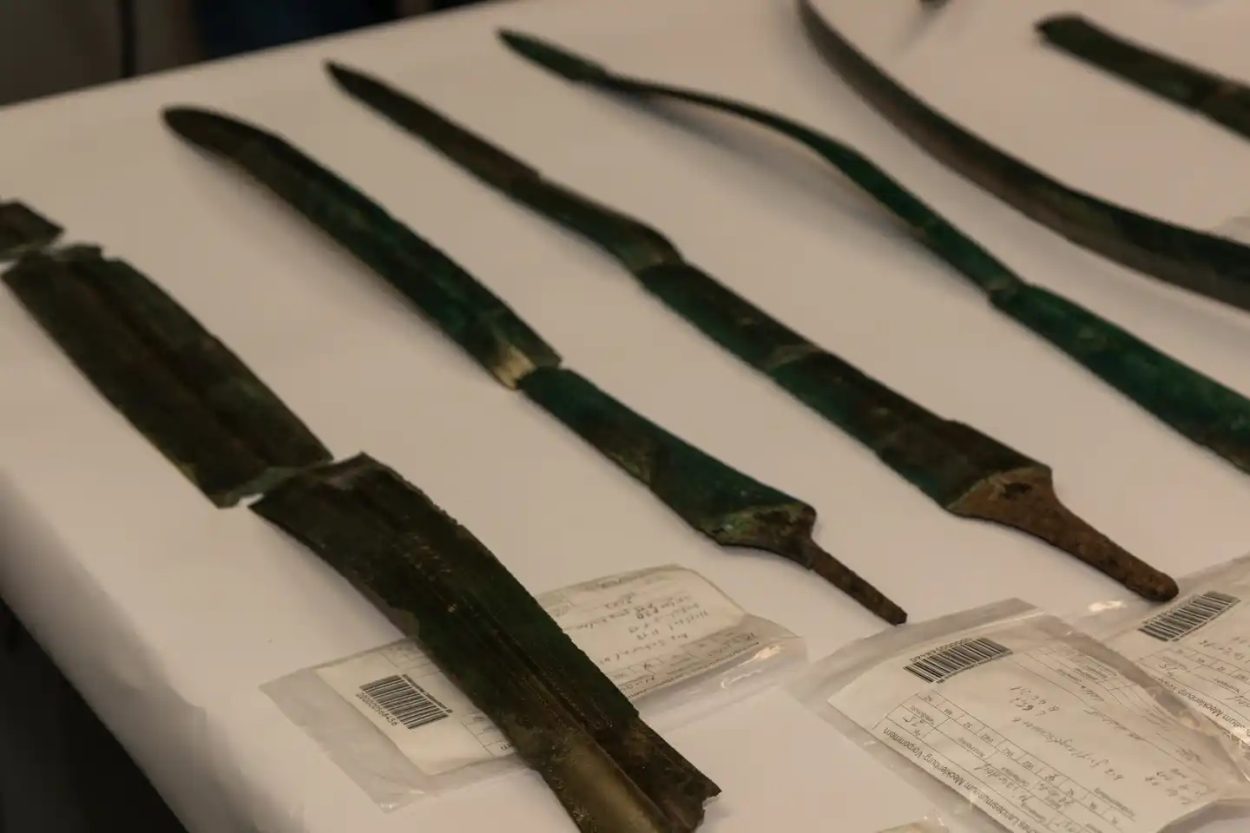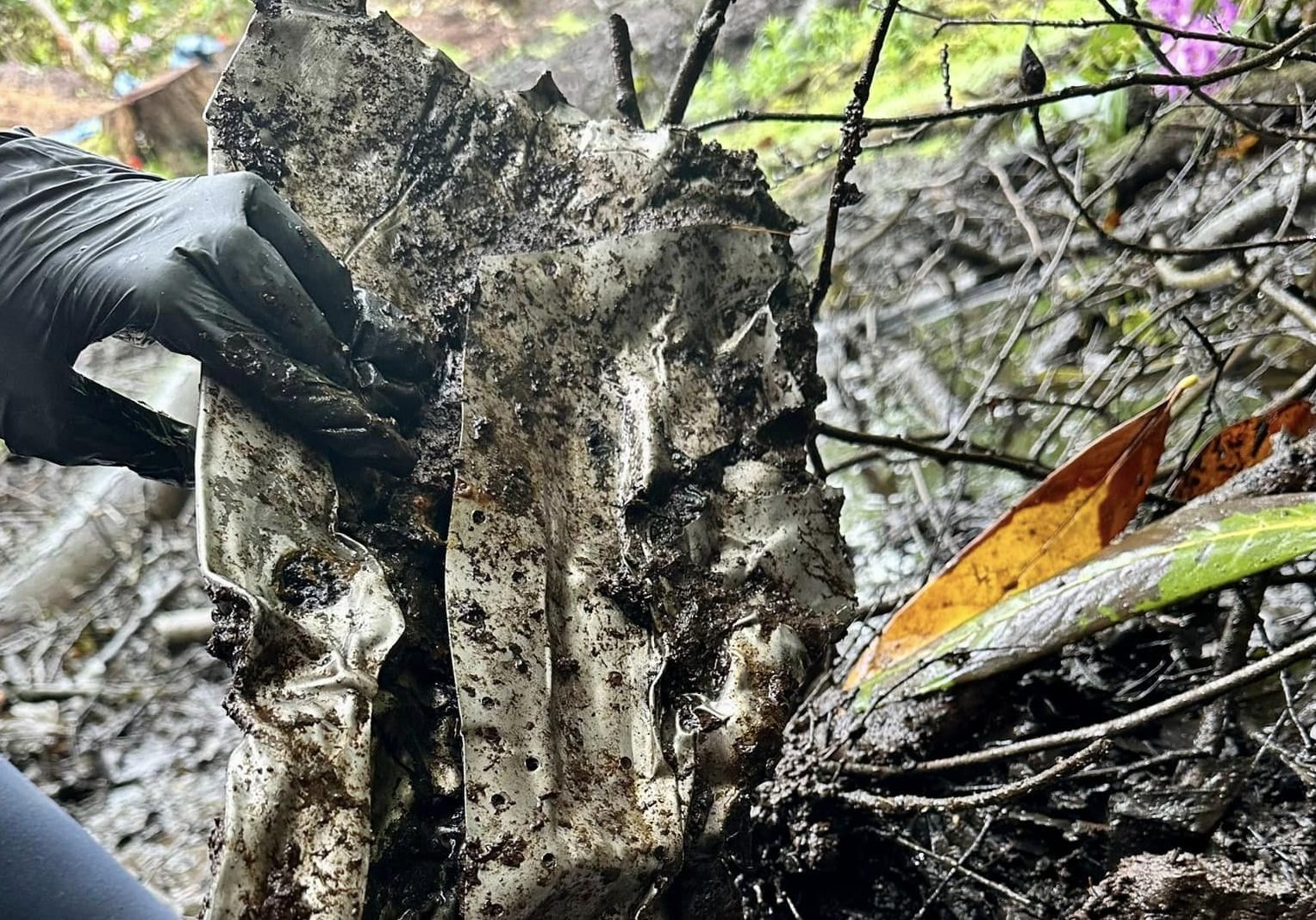Archaeology
Major archaeological discoveries in Mecklenburg-Western Pomerania

In an announcement by the State Office for Culture and Monument Preservation (LAKD), archaeologists excavating in the German state of Mecklenburg-Western Pomerania have uncovered seven Bronze Age swords, 6,000 silver coins, and two Christian reliquary containers.
The swords were found in fragments near Mirow in the Mecklenburg Lake District, which were likely dispersed on the surface following dredgeing activities to excavate a trench.
According to the researchers, the swords were deposited as votive or sacrificial offerings during the Bronze Age around 3,000-years-ago.
“Although such deposits of valuable items are not unusual, so many Bronze Age swords have never been discovered in one place in Mecklenburg-Western Pomerania,” said the researchers.
Image Credit : State Office for Culture and Monument Preservation (LAKD)
Also in the LAKD announcement is the discovery of a treasure hoard near Rügen, consisting of 6,000 silver coins from the 11th century. The hoard was deposited in a clay pot, with hundreds of coins dispersed over the surface as a result of agricultural activity.
An examination of the coins have identified that the majority originate from Western Germany and the Meißen-Upper Lusatia region, however, around 10% of the coins originate from England, Denmark, Bohemia, and Hungary.
“The find is the largest Slavic coin hoard of the post-war period to date. The coin discovery therefore allows conclusions to be drawn about possible trade relationships in the 11th century,” said the researchers.
Another remarkable discovery are two distinctive reliquary containers shaped as a captorge and a crucifix which were unearthed in the Mecklenburg Lake District. Alongside the reliquary containers, archaeologists also found 1,700 coins, rings, a pearl necklace, rock crystals, and carnelian beads.
According to the announcement: “These two reliquary containers stand out significantly, serving as rare evidence of the Christian faith in a region that was predominantly influenced by other beliefs during that era.”
Header Image Credit : State Office for Culture and Monument Preservation (LAKD)
This content was originally published on www.heritagedaily.com – © 2023 – HeritageDaily
Archaeology
Archaeologists search crash site of WWII B-17 for lost pilot

Archaeologists from Cotswold Archaeology are excavating the crash site of a WWII B-17 Flying Fortress in an English woodland.
The B-17 Flying Fortress is an American four-engine heavy bomber aircraft developed in the 1930s for the United States Army Air Corps (USAAC).
The bomber was mainly used in the European theatre for daylight strategic bombing, complimenting the RAF Bomber Command’s night bombers in attacking German industrial, military and civilian targets.
Cotswold Archaeology have been tasked by the Defense POW / MIA Accounting Agency to search the crash site for the remains of the pilot, who died when the B-17 crashed following a system failure in 1944.
Image Credit : Cotswold Archaeology
At the time, the plane was carrying a payload of 12,000lbs of Torpex, an explosive comprised of 42% RDX, 40% TNT, and 18% powdered aluminium. Torpex was mainly used for the Upkeep, Tallboy and Grand Slam bombs, as well as underwater munitions.
The pilot was declared MIA when the plane exploded into an inferno, however, using modern archaeological techniques, the researchers plan to systematically excavate and sieve the waterlogged crash site to recover plane ID numbers, personal effects, and any surviving human remains.
It is the hope of the excavation team members that they will be able to recover the pilot’s remains and return him to the United States for burial with full military honours.
The Defense POW/MIA Accounting Agency (DPAA) is an agency within the U.S. Department of Defense whose mission is to recover unaccounted Department of Defense personnel listed as prisoners of war (POW) or missing in action (MIA) from designated past conflicts.
Header Image Credit : Cotswold Archaeology
Sources : Cotswold Archaeology
This content was originally published on www.heritagedaily.com – © 2023 – HeritageDaily
Archaeology
Roman Era tomb found guarded by carved bull heads
Archaeologists excavating at the ancient Tharsa necropolis have uncovered a Roman Era tomb guarded by two carved bull heads.
Tharsa is located near Kuyulu village in southeastern Turkey along the Adıyaman-Şanlıurfa Highway.
The site was situated on a major Roman highway from Doliche to Samosata, which today consists of a two settlement mounds and a large necropolis that dates from the 3rd century to the Byzantine period.
Excavations first commenced in 2021 which discovered a collection of Turuş Rock Tombs, a type of tomb construction carved directly into the bedrock.
In the latest season, archaeologists have excavated another Turuş Rock Tomb, however, this example was found to have two carved bull heads which is decorated with garlands and rosettes between the horns.
Bull heads, known as Bucranium, were a form of carved decoration commonly used in Classical architecture. In Ancient Rome, bucrania were often used on the friezes of temples in the Doric order of architecture, later influencing the architecture of buildings from the Renaissance, Baroque, and Neoclassical periods.
Architectural examples of bucrania are representations of the practice of displaying garlanded, sacrificial oxen, whose heads were displayed on the temple walls.
Like similar Turuş Rock Tombs, the bull heads are carved directly into the bedrock, guarding a dozen rock cut steps descending into the burial chamber which has three arched niches known as acrosolia.
Mustafa Çelik, Deputy Director of Adıyaman Museum, said, “Tharsa Ancient City consists of 3 main archaeological areas: Big Mound, Small Mound and Necropolis Area. We started excavations in the necropolis area in 2024. We added 2 more rock tombs to the rock tombs we had previously uncovered. One of them is the rock tomb we identified today.”
Header Image Credit : Adıyaman Museum
Sources : Adıyaman Museum
This content was originally published on www.heritagedaily.com – © 2023 – HeritageDaily
-

 Ghosts2 years ago
Ghosts2 years agoZozo: The Ouija Board Demon
-

 Space2 years ago
Space2 years agoScientists claim to have found the answer what existed before the Universe
-

 Ghosts2 years ago
Ghosts2 years agoOld Coot of Mount Greylock
-
Archaeology1 year ago
New discoveries at Ekʼ Balam during conservation works
-

 General3 years ago
General3 years agoUC San Francisco engaging in horrifying experiments, organ harvesting of live babies in the name of “science”
